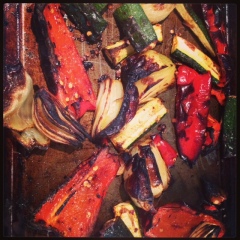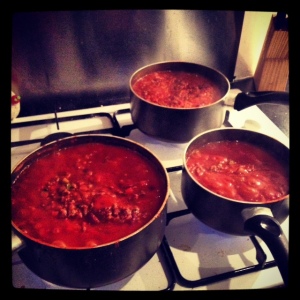 As per the title of this post, a Sunday Roast is not a Sunday Roast without YORKSHIRE PUDDINGS… and many of them. Don’t get me wrong, I do love going out for a Sunday Lunch, however I only ever get ONE Yorkshire Pudding and I find that very very upsetting.
As per the title of this post, a Sunday Roast is not a Sunday Roast without YORKSHIRE PUDDINGS… and many of them. Don’t get me wrong, I do love going out for a Sunday Lunch, however I only ever get ONE Yorkshire Pudding and I find that very very upsetting.
When I was a little girl Yorkshire Puddings were the thing we always argued every Sunday… and that was not just me and my little sister. That was my Mum and Dad too! My mum would make a ‘batch’ of yorkshire puddings. Sometimes this would be 12 and as we got older it would be 16. Then when Mark joined our family (my wee sisters other half) we started making 20. So… ‘3 each’ or ‘4 each’ was the rule shouted as they were brought into the dining room. During the meal we would ask each other ‘how many have you had?’ and we would systematically go around the table. Sometimes LIES were told. This would cause chaos… especially if you had simply and innocently forgotten how many you had (cough cough).
So… we grew up with Mum making Yorkshire Puddings every Sunday and therefore my sister and I are adept at making Yorkshire’s. I therefore find it very ODD that people are shocked and amazed when I whip up a batch and don’t rely on Aunt Bessie’s fake, thin and skimpy puddings. OH NO. If I did that Mum would disown me, and rightly so.
In fact neither my sister nor I use a recipe, so this is going to be quite hard for me to write! But here we go…
PREPARATION TIME: 10 minutes
COOKING TIME: 15 minutes
MAKES: 12 Yorkshire Puddings
INGREDIENTS:
- 4 heaped tablespoons of plain flour
- A pinch of salt
- 1 egg
- Milk (enough to make a smooth batter)
- Vegetable oil / lard /butter
HOW TO MAKE THE PUDDINGS…
First things first and possibly the MOST important stage. Get out the Yorkshire Pudding tin… which is the one that is smaller than a muffin tin and is used to bake buns not cupcakes. (I hope this makes sense!) To each well in the Yorkshire Pudding tin add 1/2 a teaspoon of oil/butter/lard. I prefer to use vegetable oil as I don’t think it adds a taste to the puddings. Now place this in a hot oven – so heat the oven to 200 degrees (gas mark 5) and then place in the tray with the oil. You want to leave this to ensure that the oil is very hot, which should take about 10 minutes. Whilst this heats up, lets make the batter…
In a medium sized bowl (or if you are like me I find it easier to use a measuring jug, as it will allow me to pour the mixture out neatly) place the 4 heaped tablespoons of plain flour in and add to that the pinch of salt (but only a pinch).
Mix together the salt and flour and then make a well in the centre – a hole! (I say this to the children I work with and they look at me like I am crazy!!) It simply means make a space in the centre. Into here add the egg (obviously crack it open!) and then add a good glug of milk. If you want some help here, about 6 tablespoons of milk – but it doesn’t matter if its slightly more or less at this stage.
Now, using a fork start whisking the egg and milk (only) in the centre. Keep going and you will notice that gradually the flour starts to stick and come into the mix, keep going and going until a lot of the flour has come into the milk/egg now you should be starting to get a think paste… don’t let it get too thick as so far you will have avoided lumps.
Add a dash of milk and continue to mix. Add another dash of milk and repeat. You can now bring in the rest of the flour by mixing around the sides of the bowl and add another dash of milk.
The batter for Yorkshire Puddings and pancakes is the same, the only difference is the thickness. For pancakes you want a very thin consistency, for puddings you want a thick batter. So in between the consistency of houmous and pancake batter. (Hummm this is hard to explain). So keep adding milk until you get the batter to this consistency and whisk well to ensure there are no lumps.
Now your oil should be hot, so take the tin out of the oven (using a glove) and begin pouring in the batter. You want to fill each well up until it is approx. two thirds full – this will allow room for rising. You also need to act very quickly as you need the oil to be hot as the batter hits it. So, fill each well and then get them puddings straight into the oven.
Leave for 15 minutes and DO NOT OPEN THE OVEN. If you do they could drop and then you won’t get the impressive rise. After 15 minutes open the oven and have a peak. If they are golden they are ready. I like mine a little doughy/heavy so I take them out after 15 minutes. If you like them lighter in weight and darker in colour then leave them for another 5 minutes.
Add them to your roast dinner after declaring ‘2 each’ or ‘3 each’ and enjoy! Any leftover batter (if you are cooking for one or two) could be used as pancakes… you just need to add more milk. ENJOY and please… don’t fight.































